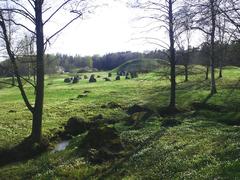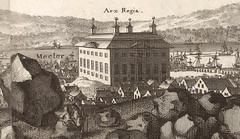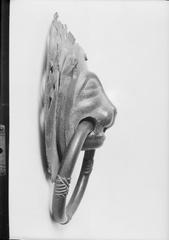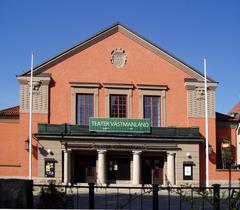Grytahögen Visiting Hours, Tickets, and Complete Guide to Västerås’ Ancient Burial Mound
Date: 14/06/2025
Introduction
Grytahögen, located in the historic region of Västerås, Sweden, is a striking Iron Age burial mound that stands as a testament to Scandinavia’s ancient heritage. Measuring about 41 meters in diameter and rising 6 meters high, it is one of the most prominent prehistoric monuments in the Mälaren Valley. As part of the storied Eriksgatan royal route, Grytahögen is not just an archaeological landmark but also a symbol of the region’s social, spiritual, and political history. Visitors to Grytahögen can immerse themselves in a landscape dotted with rune stones, ship settings, and other burial mounds—including the renowned Anundshög—providing a vivid window into Sweden’s early societies (Västerås stad; Visit Sweden).
This guide offers a comprehensive overview of Grytahögen’s historical significance, practical visiting information, travel and preservation tips, and recommendations for exploring Västerås’ ancient landscape.
Table of Contents
- Introduction
- Historical Background and Archaeological Context
- Grytahögen in the Regional Landscape
- Visiting Grytahögen: Practical Guide
- Responsible Tourism and Preservation
- Frequently Asked Questions (FAQ)
- Conclusion and Call to Action
- References
Historical Background and Archaeological Context
Origins and Significance
Grytahögen is part of a cluster of burial mounds that illuminate the development of complex societies in Iron Age and early medieval Scandinavia (c. 1000 BCE–1050 CE). These mounds served as monumental graves for elite individuals—chieftains, warriors, or influential community leaders—reflecting social hierarchy, communal effort, and spiritual beliefs (Allmogens). Their imposing size marked the power and status of those interred within.
Archaeological Insights
Although Grytahögen has not undergone extensive excavation, studies of similar mounds in the region reveal typical features: wooden burial chambers or stone cists, cremated human remains, and grave goods such as weapons, jewelry, and imported artifacts. Such findings point to long-distance trade networks and cultural exchanges across the Baltic Sea (Uppsala University).
Small stone settings on Grytahögen’s eastern side suggest the site’s use over several generations, while nearby stone circles and monuments indicate its role in broader ritual landscapes (Wikipedia).
Rituals and Cultural Traditions
Burial customs at Grytahögen were characterized by cremation, accompanied by offerings of food, drink, and animal sacrifices to honor ancestors and ensure their passage to the afterlife (ArchitectureCourses.org). The communal construction of the mound symbolized social unity and the perpetuation of cultural identity.
Grytahögen in the Regional Landscape
Connection to the Eriksgatan Royal Route
Grytahögen is strategically located along the Eriksgatan, the medieval route traveled by newly elected Swedish kings to have their authority recognized at local assemblies. This connection imbues the mound with political and symbolic significance, linking it to the legitimacy and continuity of royal power (Flickr; Wikipedia).
Comparative Analysis with Other Burial Mounds
Grytahögen is one of several monumental mounds in the Mälaren Valley, including Anundshög (Sweden’s largest), Ströbohög, and the royal mounds of Old Uppsala. While Grytahögen is not the largest, it shares in the rich tapestry of folklore and archaeological significance that defines these sites. Each mound contributes uniquely to our understanding of Scandinavian rituals, power structures, and ancestral reverence (Allmogens; Wikipedia).
Visiting Grytahögen: Practical Guide
Visiting Hours and Entry
- Open: Year-round, 24/7, as an outdoor site.
- Entry Fee: Free of charge—no tickets or reservations required.
- Recommended Times: Daylight hours, particularly May–September for favorable weather and lush scenery.
Accessibility and Travel Options
- Location: Along Tortunavägen in Skiljebo, Västerås; approximately 5–7 km from the city center.
- By Car: Free parking available near the site.
- By Public Transport: Regular city buses serve the Skiljebo district; check current schedules for routes to Grytahögen.
- By Bicycle: Dedicated cycling paths connect Grytahögen with other historical sites, including Anundshög (Västerås stad; Visit Sweden).
Facilities and Visitor Experience
- On-Site Facilities: Limited—no restrooms or cafés; nearest facilities at Anundshög or in central Västerås.
- Signage: Informative boards provide historical context (mostly in Swedish).
- Terrain: Grassy, uneven, and natural; sturdy footwear is advised.
- Accessibility: Wheelchair access is limited due to the terrain; nearby visitor centers offer better accessibility solutions.
- Etiquette: Stay on marked paths, do not climb the mound, and respect the site’s heritage.
Guided Tours and Events
- Guided Tours: Not regularly available at Grytahögen itself, but local museums and the Västerås tourist office offer tours including Grytahögen and other sites along the Eriksgatan.
- Events: Occasional cultural walks and educational programs are organized by local heritage groups and museums; check Visit Västerås and Västmanlands läns museum for schedules.
Nearby Attractions
- Anundshög: Sweden’s largest burial mound, featuring rune stones, ship settings, and a visitor center (Ancient Pages).
- Västerås Cathedral: A prominent historical monument in the city center.
- Other Sites: Stone circles, rune stones, and additional burial mounds along the Eriksgatan route.
Responsible Tourism and Preservation
Grytahögen is protected under Swedish cultural heritage laws. Visitors play a vital role in preserving the site by:
- Staying on designated paths to prevent erosion.
- Not disturbing stones, plants, or potential artifacts.
- Carrying out all trash, as there are no bins on-site.
- Supporting local businesses and sustainable travel options.
- Treating the mound with respect as a place of remembrance and cultural significance (Tourist Secrets – Responsible Tourism).
Frequently Asked Questions (FAQ)
Q: What are Grytahögen’s visiting hours?
A: The site is open 24/7, year-round, as an outdoor archaeological monument.
Q: Is there an entrance fee or ticket required?
A: No, access to Grytahögen is free.
Q: Is Grytahögen accessible for those with disabilities?
A: The site’s uneven terrain limits wheelchair access, but nearby visitor centers have better facilities.
Q: Are guided tours available?
A: Occasional tours are offered by local museums and tourist offices; check event listings for current information.
Q: What are the best times to visit?
A: May–September, during daylight hours, for pleasant weather and optimal conditions.
Q: What should I bring?
A: Sturdy footwear, water, weather-appropriate clothing, and a camera.
Conclusion and Call to Action
Grytahögen is a captivating gateway to Sweden’s Iron Age and Viking past, offering free and open access to one of Västerås’ most significant ancient sites. Its historical associations with the Eriksgatan royal route and its place in a landscape rich with burial mounds and rune stones make it a must-see for anyone interested in history, archaeology, or cultural heritage.
Plan your visit to Grytahögen and explore the broader Västerås region by combining your trip with nearby attractions such as Anundshög and Västerås Cathedral. For interactive maps, guided audio tours, and up-to-date event information, download the Audiala app and follow local heritage organizations on social media. Embrace responsible tourism and become a part of preserving Sweden’s remarkable archaeological legacy for generations to come.
References and Further Reading
- Västerås stad: Information on Grytahögen and Skiljebo district
- Visit Sweden: Västerås and Västmanland region guide
- Uppsala University: New light cast on Scandinavia’s most important Bronze Age site
- Allmogens: Spannande gravhögar – Swedish burial mounds overview
- The Crazy Tourist: 15 best things to do in Västerås, Sweden
- Wikipedia: Grytahögen article
- Visit Västerås: Official tourism website
- Ancient Pages: Anundshög, Sweden’s largest burial mound
- Tourist Secrets – Responsible Tourism
- Västmanlands läns museum: Digital collection
- Flickr: Eriksgatan and burial mounds
- European Culture: Västerås historical sites





